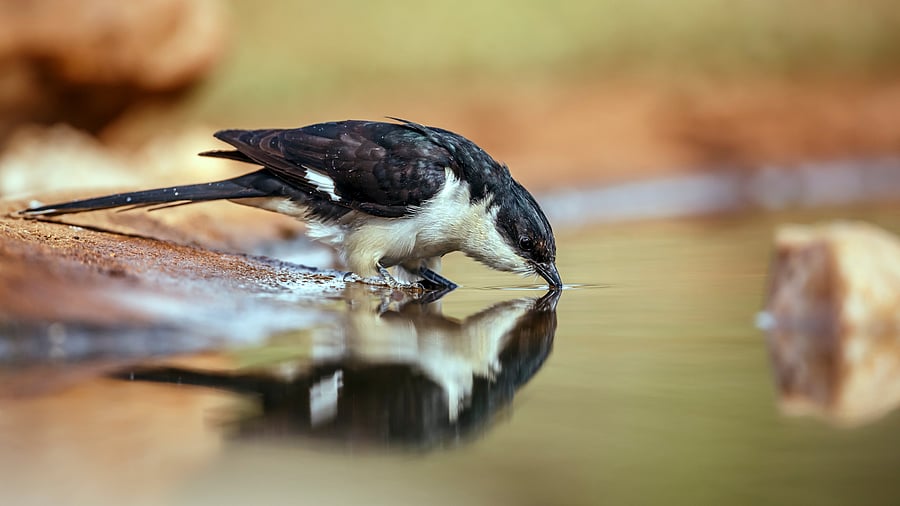
It is my favourite time of the year — the season of monsoon showers that cleanse and cool the baked earth. Rain-drenched, dew-dappled leaves in all hues of green, the earthy scent of petrichor, the hypnotic rhythm of pouring rain…they all constellate to soothe the senses.
Three monsoons earlier, in the countryside at Navilu Kaadu, a mercurial addition to this heady sensorial mélange elevated the magic several notches. Early one morning, a ringing ‘piu-piu’ call resounded across slate-grey skies. I spotted a black and white bird with a raffish crest, perched on the tallest limb of our dried-up Banni mara — it was the Jacobin cuckoo, also called the pied cuckoo (Clamator jacobinus). In birding parlance, ‘pied’ denotes black and white plumage, and so, we have the oriental pied hornbill, the pied wagtail, the pied kingfisher and so on. This makes Zoey, our black and white mutt, a pied mop tail!
Like all cuckoos, the pied cuckoo is a brood parasite and outsources parenting to other birds, usually unsuspecting babblers that are aplenty in our neck of the woods around Navilu Kaadu.
While the pied cuckoos are year-round residents in southern India and migrate locally for breeding, the central and north Indian pied cuckoo subspecies are said to journey from Africa, riding the monsoon winds across the Arabian sea (as per Bird Count India, referenced further below). They relish insects and hairy caterpillars.
Fabled as the harbinger of the monsoon rains in India, the pied cuckoo finds mention in Kalidasa’s Sanskrit poem Meghadhuta, as the thirsty Chaathaka catching raindrops from the sky.
Our ever-observant ancestors figured that sighting the Chaathaka pakshi meant rains would soon follow. The arrival of the bird may have served as a cue for farmers of the time to prep their fields for the rains ahead. It is romanticised that the pied cuckoo goes without water all year round, calling to the rain clouds and drawing in the monsoon, to quench its thirst. The captivating lore of the Chaathaka heralding the onset of the monsoon in the Indian subcontinent has endured across aeons. The legend of the rain bird and its arrival on the cusp of the southwest monsoon piqued the curiosity of present-day scientists, too. Is the pied cuckoo truly the bellwether of monsoon rains?
M D Madhusudan, senior scientist and co-founder of Mysuru-based Nature Conservation Foundation (NCF), investigated the phenomenon with some cool technological interventions. He utilised Google Earth Engine and Google Earth Outreach, a remote sensing analysis platform, to correlate historical records of the Indian monsoons with multi-year data on seasonal sightings of pied cuckoos across the Indian subcontinent. This second set of data on sighting patterns was enabled by the work of another senior scientist at NCF, Suhel Quader, who co-founded Bird Count India, a vast online database that crowdsources seasonal sightings of birds by tens of thousands of citizen volunteers. The database is housed on eBird, the global online bird sighting platform.
Intrigued, I poked about the cloud (not the rain-bearing sort!) for Madhusudan’s pied cuckoo and monsoon correlation project on the Earth Engine. I watched wide-eyed as my laptop screen displayed the grey-toned Indian landmass, and the Earth Engine unravelled the grand monsoon odyssey across the vast subcontinent.
A timeline ticker at the bottom displayed the date and month. For April, the Earth Engine showed a speckled pale-red mass representing the pied cuckoo’s presence in the southern region of the Indian peninsula. As the ticker progressed beyond mid-May, the red swarm denoting the pied cuckoo sightings started to fan out towards the central and northern regions, even as a white amoeba-like mass, representing the progress of the Indian monsoon, wiggled and closely followed and overlapped with the swarm, pushing northwards from the southwest of the peninsula and the eastwardly direction. By July end, the pied cuckoo sightings had progressed beyond the Gangetic plains, reaching the lower Himalayan ranges, and the wiggling amoeba now sheathed most of the Indian landmass in white and blue, the life-sustaining monsoon rains sopping the land. After all, the great Indian monsoon did follow the rain bird’s peregrination across the Indian subcontinent.
With shifting weather patterns and vanishing green cover throwing nature’s rhythm off balance, will the pied cuckoo continue to herald the monsoon rains? Only time will tell.
Rooting for Nature is a monthly column on an off-kilter urban family’s trysts with nature on a natural farm. The author runs Green Goobé, a sustainable venture committed to a greener, cleaner planet. Reach her at bluejaydiaries@gmail.com